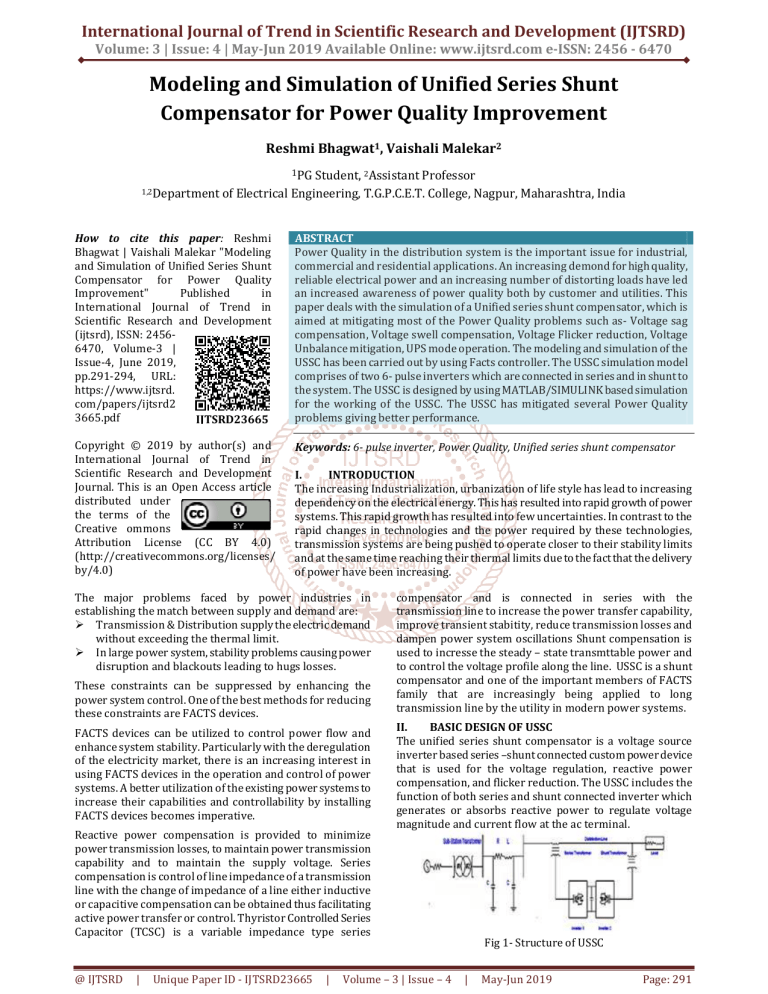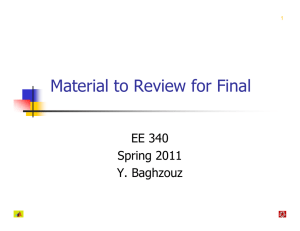
International Journal of Trend in Scientific Research and Development (IJTSRD)
Volume: 3 | Issue: 4 | May-Jun 2019 Available Online: www.ijtsrd.com e-ISSN: 2456 - 6470
Modeling and Simulation of Unified Series Shunt
Compensator for Power Quality Improvement
Reshmi Bhagwat1, Vaishali Malekar2
1PG Student, 2Assistant Professor
1,2Department
of Electrical Engineering, T.G.P.C.E.T. College, Nagpur, Maharashtra, India
How to cite this paper: Reshmi
Bhagwat | Vaishali Malekar "Modeling
and Simulation of Unified Series Shunt
Compensator for Power Quality
Improvement"
Published
in
International Journal of Trend in
Scientific Research and Development
(ijtsrd), ISSN: 24566470, Volume-3 |
Issue-4, June 2019,
pp.291-294, URL:
https://www.ijtsrd.
com/papers/ijtsrd2
3665.pdf
IJTSRD23665
ABSTRACT
Power Quality in the distribution system is the important issue for industrial,
commercial and residential applications. An increasing demond for high quality,
reliable electrical power and an increasing number of distorting loads have led
an increased awareness of power quality both by customer and utilities. This
paper deals with the simulation of a Unified series shunt compensator, which is
aimed at mitigating most of the Power Quality problems such as- Voltage sag
compensation, Voltage swell compensation, Voltage Flicker reduction, Voltage
Unbalance mitigation, UPS mode operation. The modeling and simulation of the
USSC has been carried out by using Facts controller. The USSC simulation model
comprises of two 6- pulse inverters which are connected in series and in shunt to
the system. The USSC is designed by using MATLAB/SIMULINK based simulation
for the working of the USSC. The USSC has mitigated several Power Quality
problems giving better performance.
Copyright © 2019 by author(s) and
International Journal of Trend in
Scientific Research and Development
Journal. This is an Open Access article
distributed under
the terms of the
Creative ommons
Attribution License (CC BY 4.0)
(http://creativecommons.org/licenses/
by/4.0)
Keywords: 6- pulse inverter, Power Quality, Unified series shunt compensator
I.
INTRODUCTION
The increasing Industrialization, urbanization of life style has lead to increasing
dependency on the electrical energy. This has resulted into rapid growth of power
systems. This rapid growth has resulted into few uncertainties. In contrast to the
rapid changes in technologies and the power required by these technologies,
transmission systems are being pushed to operate closer to their stability limits
and at the same time reaching their thermal limits due to the fact that the delivery
of power have been increasing.
The major problems faced by power industries in
establishing the match between supply and demand are:
Transmission & Distribution supply the electric demand
without exceeding the thermal limit.
In large power system, stability problems causing power
disruption and blackouts leading to hugs losses.
These constraints can be suppressed by enhancing the
power system control. One of the best methods for reducing
these constraints are FACTS devices.
FACTS devices can be utilized to control power flow and
enhance system stability. Particularly with the deregulation
of the electricity market, there is an increasing interest in
using FACTS devices in the operation and control of power
systems. A better utilization of the existing power systems to
increase their capabilities and controllability by installing
FACTS devices becomes imperative.
Reactive power compensation is provided to minimize
power transmission losses, to maintain power transmission
capability and to maintain the supply voltage. Series
compensation is control of line impedance of a transmission
line with the change of impedance of a line either inductive
or capacitive compensation can be obtained thus facilitating
active power transfer or control. Thyristor Controlled Series
Capacitor (TCSC) is a variable impedance type series
@ IJTSRD
|
Unique Paper ID - IJTSRD23665
|
compensator and is connected in series with the
transmission line to increase the power transfer capability,
improve transient stabitity, reduce transmission losses and
dampen power system oscillations Shunt compensation is
used to incresse the steady – state transmttable power and
to control the voltage profile along the line. USSC is a shunt
compensator and one of the important members of FACTS
family that are increasingly being applied to long
transmission line by the utility in modern power systems.
II.
BASIC DESIGN OF USSC
The unified series shunt compensator is a voltage source
inverter based series –shunt connected custom power device
that is used for the voltage regulation, reactive power
compensation, and flicker reduction. The USSC includes the
function of both series and shunt connected inverter which
generates or absorbs reactive power to regulate voltage
magnitude and current flow at the ac terminal.
Volume – 3 | Issue – 4
Fig 1- Structure of USSC
|
May-Jun 2019
Page: 291
International Journal of Trend in Scientific Research and Development (IJTSRD) @ www.ijtsrd.com eISSN: 2456-6470
Power system consists of 3 kind of power active, reactive,
and apparent power. Active power is the useful or true
power that performs a useful work in the system. Reactive
power is caused entirely by energy storage component. The
apparent power is the combination of active power &
reactive power. Power system consists of 3 principle
components they are generation, transmission, and
distribution system. Fig 1 shows the basic components used
in the simulation model. The capacitor plays an important
role in the USSC operation by acting as a dc source to provide
reactive power to the load and to regulate the DC voltage.
MODELING OF USSC
III.
The static compensator is one of the most prominent
members in the family of FACTS devices, which is connected
in shunt to the transmission grid. It is usually used to control
transmission voltage by reactive power compensation. In
ideal steady state analysis, it can be assumed that active
power exchange between the AC system and the USSC can be
neglected, and only the reactive power can exchanged
between them.
IV.
Evolutionary Algorithm For load Flow with USSC
Evolutionary algorithms are search methods that take their
inspiration from natural selection and survival of the fittest
in the biological world. Genetic Algorithm is one of the
evolutionary Algorithms search technique. The method was
developed by John Holland Genetic Algorithms are global
search techniques based on the mechanism of natural
selection and genetics. They can search several possible
solutions simultaneously and produces high quality
solutions. The goal of FIG Fig 3 = Flow chart for Genetic
Algorithm optimization is to find out the best optimal
location of TCSC and USSC in power system using genetic
algorithum. The genetic algorithm follows the following
steps:
Step 1: Genetic an initial population of binary string.
Step 2: Calculation fitness value of each member of
population based on the problem type.
Step 3: Generate off spring string through reproduction,
crossover and mutation and evalution.
Step 4: Calculate fitness value for each string.
Step 5: Terminate the process if required solution is
obtained or number of generation is attained. The above
process is represented in flow chart as shown in fig 3.
Fig 2 – MODEL OF USSC
The presence of FACTS controllers is accommodated and
accounted for by adding new equation to the set of the
power flow equation and modifying some of the existing
power flow equation as needed. The Jacobian equation is
modified accordingly. Fig 2 shows the circuit model of a
USSC connected to Bus k of an N- Bus power system, the
subscript ‘p’ means the USSC is connected in parallel with
the power system. The USSC is modelled as a controllable
voltage source (Ep) in series with impedance. The power
flow equation for a bus i of the power system with no FACTS
controlleris given by :
Pi = ∑nj=1 | Vi||Vj||Yij| cos ( δi – δj – θij)
(1)
Qi = ∑ nj=1 |Vi||Vj||Yij| sin ( δi - δj -θij )
(2)
Where Vi represents complex voltage of a bus i and Yij
represent (i,j) entry of the Y matrix . With the addition of
USSC connected at bus k the power flow equation of the
system remain same as the power flow equation of the
system without USSC for all buses given by eq. 1,2.
Fig 3 = Flow chart for genetic algorithm
SIMULATION MODEL OF USSC
V.
The concept of custom power is the employment of power electronic controllers in medium voltage distribution systems
aiming to supply a reliable and higher quality power that are needed by sensitive users. The main aim of the present simulation
is to explore the capabilities of a USSC in mitigating power quality problems.
@ IJTSRD
|
Unique Paper ID - IJTSRD23665
|
Volume – 3 | Issue – 4
|
May-Jun 2019
Page: 292
International Journal of Trend in Scientific Research and Development (IJTSRD) @ www.ijtsrd.com eISSN: 2456-6470
Fig 4 = Simulation Mdel of USSC
VI.
SIMULATION RESULT OF USSC
Fig a = Result of Load Current
Fig b = RESULT OF SOURCE CURRENT
Fig c = RESULT OF CAPACITOR VOLTAGE
Fig d = RESULT OF CAPACITOR CURRENT
@ IJTSRD
|
Unique Paper ID - IJTSRD23665
|
Volume – 3 | Issue – 4
|
May-Jun 2019
Page: 293
International Journal of Trend in Scientific Research and Development (IJTSRD) @ www.ijtsrd.com eISSN: 2456-6470
VII. CONCLUSION
The work on Evolutionary Algorithm assisted Optimal
Placement of FACTS Controllers in powe system has been
carried out to find optimai location of TCSC and USSC to
improve the losses and voltage profile of the system . The
optimal placement of FACTS controllers has been attemped
using genetic algorithm. The developed algorithm is effictive
in deciding the placement of FACTS device. USSC helps in
diverting flow from heavily loaded lines and results in
reduction in active power losses. USSC helps in improving
voltage profile of the system and also results in reduced
active power losses.
REFERENCES
[1] Abdul Majeed Khaskheli, Mukhtiar Ahmed Mahar,
Abdul Sattar Larik,” Power Quality Improvement In
Power System Network Using Unified Power Flow
Controller”978-1-5386-6594-7/18/$31.00@2018IEEE.
[2] Mojtaba Ahanch, Mehran Sanjabi Sasi, Heider Ali
Shayanfar “Considering Shunt Fixed Series
Compensation In Dynamic Transmission Network
Expansion Planning Using Real Codded Genetic
Algorithum”, 2017 IEEE International Conference On
Knowledge Based Engineering And Innovation Dec.
22nd 2017.
[3] petre v. Chernayaev, maxim a. Khazov, andrey n.
Belyaev, ”operating condition analysis of flexible ac
transmission lines with controlled analysis of flexible ac
transmission lines with controlled seres and shunt
compensation devices”, institution of energy and
transport system department of electrical power
system
and
network
978-1-5386-43402/18/$31.00@2018IEEE
[4] Shunsuke Tamada Hiroshi Mochikawa, Yuji Watanbe
“Development Of Continuous Series Voltage
Compensation For Load Voltage Regulation And
Negative Sequence Compensation In A 6.6 Kv
Distribution Line”, Tosiba Carporation Power And
Industrial Systems R &D Center 2017 IEEE.
[5] Houriyeh Shadmehr, Riccardo Chiumeo Chiara Gandolfi,
“Logical Cordination between LV Compensation
Devices to Provide Different PQ Levels in the
Distribution
Network”,
978
-1-5386-05172/18/$31.00@2018IEEE.
[6] Shaswat Chirantan, Ramankant Jena, Dr. S.C. Swain, Dr.
P.C. Panda,” Comparative Analysis Of STATCOM And
TCSC FACTS Ontroller For Power Profile Enhancement
In A Long Transmission Line”, 978-1-50130/17/$31.00@2017IEEE.
Phase Voltage Sag Mitigation”, 978-1-5090-25978/16/$31.00@2016IEEE.
[8] Jarupula Somlal, Venu Gopala Rao, Narsimh Rao,
Vultlapalli, ”Power Quality Improvement In
Distribution System Using Ann Based Shunt Active
Power Filter ”, International Journal Of Power
Electronic And Drive System Vol. 5 No. 4 April 2015.
[9] K. Bavitra, Sinthuja And N. Manoharan, “Effective Power
Quality Improvement Using Generalised Unified Power
Quality Conditioner” Indian Journal Of Science And
Technology, Vol 191- 197, Nov. 2014.
[10] Bahr Eldin, S. M. K. S. Rama Rao Rsdiazli Ibrahim, N.
Perumal “Cascade Multi Level Converter Based
Generalized Unified Power Quality Conditioner”2012
International Conference On Intelligent And Advanced
System,978-1-4577-1967-7/12/$26.00@2012IEEE.
[11] Md Ashfanoor Kabir And Upal Mahbub, “Syschronous
Detection And Digital Control Of Shunt Active Filter In
Power Quality Improvement”, 978-1-4244-80524/11/$26.00@2011ieee.
[12] M. Basu, S. P. Das, G. K. Dubey, ”Investigation On The
Performance Of Upqc –Q For Voltage Sag Mitigation
And Power Quality Improvement At A Critical Load
Point”, Gener. Transm. Distrib. 2008, Vol. 2 No. 3 .
[13] O. Anaya Lara E. Acha “Modeling And Ananlysis Of
Custom Power System By Pscad/Emtdc”, Ieee Trans.
Power Delivery, Vol. 17, No. 266-272, Jan. 2002.
[14] S. Ravi Kumar S. Sivangaraju,” Simulation Of D-Statcom
And Dvr In Power System ”, Arpn Journal Of
Engineering Nd Applied Science, Vol. 2,No. 3 June 2007.
[15] Bor –Ren Lin Senior Member, IEEE . Cheng Chang Yang
And Chien Lan Huang “Series And Shunt Compensator
For Power Quality Compensation”, National Yunlin
Univercity Of Science And Technology 2006 IEEE.
[16] M. A. Hannan And Azad Mohamed Member IEEE
“Simulation Of Unified Series Shunt Compensator For
Power Quality Improvement”, IEEE Transation On
Power Delivrery Vol. 20, No. 2, April 2005.
[17] M. A. Nhannan . A Mohamed, A. Hussain And Majid Ai
Dabby, ”Development Of The Unified Series Shunt
Compensator For Power Quality Mitigation” American
Journal Of Applied Science 2009.
[18] W. Freitas, A. Morelao, Comperative Study Between
Power System Bolcket And Pscad/Emtdc For Transient
Analysis Of Custom Power Devices Based On Voltage
Source Converter “USA 2003.
[7] Watcharin
Srirattanawichaikul
And
Yuttana
Kumsuwan, ”Static Series Connected Compensator With
Load Connected Shunt Converter Based On Single
@ IJTSRD
|
Unique Paper ID - IJTSRD23665
|
Volume – 3 | Issue – 4
|
May-Jun 2019
Page: 294







